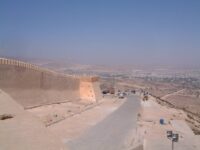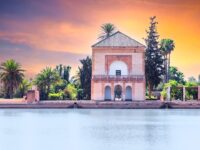The old kasbah

This kasbah, built in 1540 by Mohamed ech-Sheikh saw its fate reduced to ashes with the earthquake and tidal wave of 1960. In 15 seconds, several thousand people died, all buried under the rubble that now forms what remains of the invincible kasbah. Dwellings, restaurants, wells, mosque were to reflect the grandeur of the city. The collective granaries (from the Arabic name Agadir) were numerous and the fortified enclosure protected against foreign attacks, especially from the Portuguese. No construction is possible on this place to respect the buried dead. Only the ramparts have been rebuilt identically (except for the color which was ochre). The view on the new city and the port is exceptional.
On the heights of Agadir, you can read an inscription on a hill: it is written God Fatherland King. Above, is the old kasbah. Here, more than 40 years ago, was still a part of Agadir, a city already open to tourism and booming. This kasbah, built in 1540 by Mohamed ech-Sheikh saw its fate reduced to ashes with the earthquake and tidal wave of 1960. In 15 seconds, several thousand people died, all buried under the rubble that today forms what remains of the invincible kasbah. The fault, still visible below, is impressive.
Sometimes, the families of the victims come in pilgrimage to collect themselves, to pray and to deposit a small pebble on the monument to the dead.
No construction is possible on this site and excavations are forbidden in order to respect the buried dead. Only the ramparts have been rebuilt identically (except for the color which was ochre). The view is exceptional. You can see the fishing port, the beaches, the new city, white and bright, as well as a large desert area where the buildings of the old Agadir were located, destroyed then razed after the earthquake.
At the entrance, an inscription in Dutch (fear the God and respect the King) reminds us that in the 18th century, the Dutch occupied Agadir. Accompanied by a guide, we make the “visit” of the places where houses, restaurants, wells, mosque had to reflect the greatness of the city.
Life was peaceful there. The collective granaries (from the Arabic name Agadir) were numerous and the fortified enclosure protected from foreign attacks, especially from the Portuguese. One can easily imagine the magnitude of the disaster and the agony of the victims who lie just below your feet. A real cemetery that dominates the new city 236 meters below.
Video
How to get there
The easiest way to get there is to drive north of Agadir on Mohamed V Avenue and take the right fork in the road as you leave the city. Then you take the first left (kasbah sign) and climb up the mountain. It is better to be motorized or take a small cab.
Aurobindo Marg، Bengaluru 80000, Morocco






